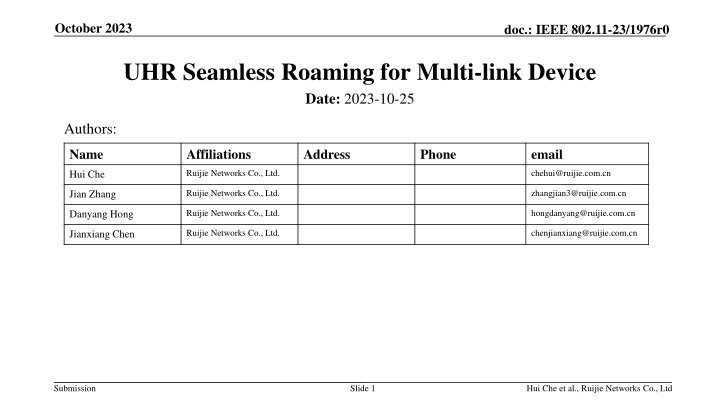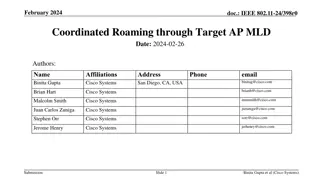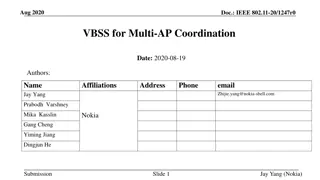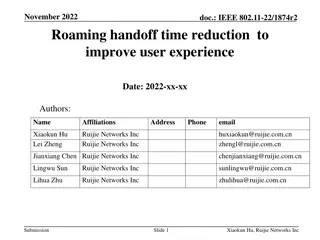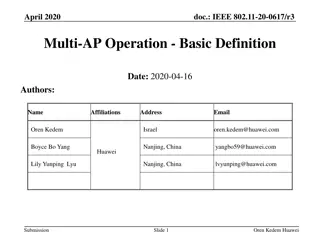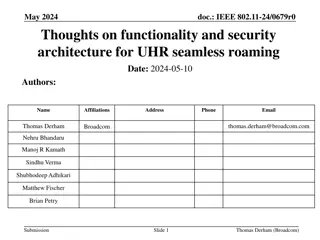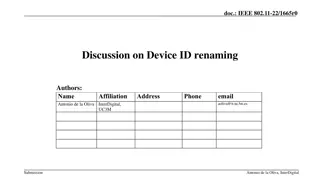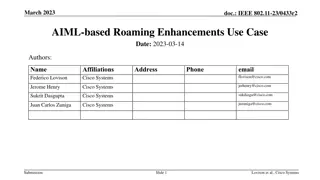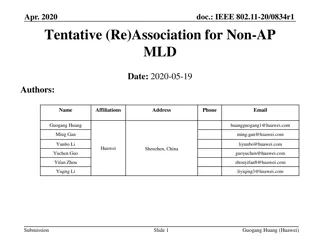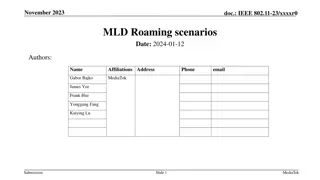Seamless Roaming for Multi-link Device in IEEE 802.11-23
Seamless Roaming scheme for non-collocated AP MLD in IEEE 802.11-23 aims to enhance roaming efficiency by utilizing multi-link operation. It addresses issues of data interruption and time wastage during traditional roaming processes. The mechanism involves sharing PTKs among non-AP STAs and storing GTKs for all AP MLDs. Roaming Frame Format Extension facilitates the handover process with seamless transitions between AP MLDs. This solution optimizes data continuity and minimizes re-authentication time for non-AP STAs.
Download Presentation

Please find below an Image/Link to download the presentation.
The content on the website is provided AS IS for your information and personal use only. It may not be sold, licensed, or shared on other websites without obtaining consent from the author.If you encounter any issues during the download, it is possible that the publisher has removed the file from their server.
You are allowed to download the files provided on this website for personal or commercial use, subject to the condition that they are used lawfully. All files are the property of their respective owners.
The content on the website is provided AS IS for your information and personal use only. It may not be sold, licensed, or shared on other websites without obtaining consent from the author.
E N D
Presentation Transcript
October 2023 doc.: IEEE 802.11-23/1976r0 UHR Seamless Roaming for Multi-link Device Date: 2023-10-25 Authors: Name Affiliations Address Phone email Ruijie Networks Co., Ltd. chehui@ruijie.com.cn Hui Che Ruijie Networks Co., Ltd. zhangjian3@ruijie.com.cn Jian Zhang Ruijie Networks Co., Ltd. hongdanyang@ruijie.com.cn Danyang Hong Ruijie Networks Co., Ltd. chenjianxiang@ruijie.com.cn Jianxiang Chen Submission Slide 1 Hui Che et al., Ruijie Networks Co., Ltd
October 2023 doc.: IEEE 802.11-23/1976r0 Abstract Introduction Roaming Model Access process Seamless Roaming procedure Roaming Frame Format Extension Conclusion Submission Slide 2 Hui Che et al., Ruijie Networks Co., Ltd
October 2023 doc.: IEEE 802.11-23/1976r0 Introduction It takes the non-AP STA a long time to do the 802.1X re-authentication and 4-way handshake for the traditional roaming scheme. This may lead to packet loss or even transmission interruption during roaming time for the single-link device. The 802.11be (EHT) standard has introduced multi-link operation (MLO) [1], and a non-AP STA multi-link device (MLD) can communicate with AP MLD over a plurality of links. However, the non-AP STA MLD spends a lot of time on the re-authentication and re-association for the fast transition (FT) roaming, and it can t ensure the continuity of data transmission. We discuss the seamless roaming scheme for UHR non-collocated AP MLD. This scheme fully utilizes the advantages of MLO to saving time and ensuring the continuity of data transmission. Submission Slide 3 Hui Che et al., Ruijie Networks Co., Ltd
October 2023 doc.: IEEE 802.11-23/1976r0 Roaming Model UHR AP MLD UMAC Non-AP STA MLD EHT AP MLD N EHT AP MLD 1 EHT Non-AP MLD UMAC EHT AP MLD UMAC EHT AP MLD UMAC Wire or Wireless Backhaul TID-to-Link Mapping /Link Merging ... TID-to-Link Mapping /Link Merging ... TID-to-Link Mapping /Link Merging ... LMAC LMAC LMAC LMAC LMAC LMAC AP 0 AP N AP 0 AP N AP 0 AP N ... ... ... Link 0 Link 0 Link N Link 0 Link N Link N Non-collocated AP MLD[2] Non-AP STA MLD The UHR non-AP STA MLD associates with the collocated AP MLD with the wire or wireless backhaul. The UHR AP UMAC can use the backhaul links to manage LMAC and PHY of the collocated EHT AP MLD. During the access process, PTK and GTK are generated using the UHR AP MLD UMAC address and EHT AP MLD LMAC Address, respectively. To achieve the seamless roaming, the PTK will be shared in non-collocated AP MLDs for the non-AP STA MLD, and the non-AP STA MLD stores the GTKs for all the AP MLDs. Seamless roaming mechanism: the non-AP STA MLD selects one of the links (e.g. STA Link0) to disconnect from the original AP MLD(e.g. EHT AP MLD1 Link0) and then connects this link (STA Link0) to the new AP MLD (e.g. EHT AP MLD2 Link0). The other links of non-AP STA MLD remain connected to the original AP until the connection with the new AP MLD is finished. Roaming Frame Format Extension: the roaming frame has been extended to advertise seamless roaming capability, invoke seamless roaming, grant seamless roaming, and confirm completion of roaming link handover. Submission Slide 4 Hui Che et al., Ruijie Networks Co., Ltd
October 2023 doc.: IEEE 802.11-23/1976r0 Access Process Non-AP MLD UHR AP MLD UHR AP MLD UMAC EHT AP MLD1 EHT AP MLD2 Link0 Link1 Link0 Link1 Link0 Link1 beacon/probe, multi-link probe/authentication multi-link association Non-AP MLD Link0 -- EHT AP MLD1 Link0 Non-AP MLD Link1 -- EHT AP MLD1 Link1 EAP/802.1X 4-way handshake AA : UHR AP MLD UMAC address SPA: Non-AP STA MLD UMAC address The PTK is generated using the UHR AP MLD UMAC address and Non-AP STA MLD UMAC address through the EAPOL-Key frame (data type MAC address KDE). The UHR AP MLD UMAC stores the PTK for non-AP STA MLD, and PTK is shared in the AP MLDs belonging to the same UHR AP MLD UMAC to achieve the later seamless roaming. GTK, IGTK and BIGTK are generated using the EHT AP MLD LMAC Address. The all EHT AP MLDs belonging to the same UHR AP MLD sends their GTK, IGTK, BIGTK to the non-AP STA MLD, and the non-AP STA MLD stores these keys. In the access process, the non-AP MLD and UHR AP MLD negotiate the unicast and multicast keys for all links of MLDs. The unicast key is shared in the non-collocated AP MLDs which are connected to the same UHR AP MLD UMAC. The non-AP STA MLD stores the all multicast keys for the non-collocated AP MLDs. The non-AP STA MLD does not need the re-authentication, re-association, and 4-way handshake, and the non-AP STA MLD directly switches the target link to reduce the authentication delay caused by FT roaming. Submission Slide 5 Hui Che et al., Ruijie Networks Co., Ltd
October 2023 doc.: IEEE 802.11-23/1976r0 Access Process: Key Design MLO GTK KDE MLO GTK Subelement Key ID Tx Reverved AP MLD ID LinkID PN GTK Subelement ID Length Key Info AP MLD ID Link ID Info Ket Length RSC Wrapped Key BITS 2 1 1 8 4 48 variable Octests: 1 1 1 8 24-40 1 1 2 MLO IGTK KDE MLO IGTK Subelement Key ID IPN Reverved AP MLD ID LinkID GTK Subelement ID Length Key ID IPN AP MLD ID Link ID Info Ket Length Wrapped Key (length-13) *8 48 BITS 16 4 8 4 Octests: 1 1 1 24-40 1 1 2 6 MLO BIGTK KDE MLO BIGTK Subelement Subelement ID Length Key ID BIPN AP MLD ID Link ID Info Ket Length Wrapped Key Key ID BIPN Reverved AP MLD ID LinkID GTK (length-13) *8 48 BITS 16 4 8 4 Octests: 1 1 1 24-40 1 1 2 6 EAPOL-Key KDE Field Extension FTE Field Extension Add AP MLD ID field to identify the different AP MLDs. The multicast key (GTK, IGTK and BIGTK) are generated using the low MAC address of each link on the AP side. For 4-way handshake, we need to expand the content of EAPOL-Key KDE (GTK KDE, IGTK KDE, BIGTK KDE) and FTE Filed (MLO GTK, MLO IGTK, and MLO BIGTK) for the FT protocol. Submission Slide 6 Hui Che et al., Ruijie Networks Co., Ltd
October 2023 doc.: IEEE 802.11-23/1976r0 Seamless Roaming Procedure (I) UHR AP MLD UMAC EHT AP MLD1 Non-AP STA MLD EHT AP MLD2 Link0 Link1 Link0 Link1 Link0 Link1 Probe Request Probe Response Probe Request Probe Response Suppose the following associations during the access process : non-AP STA MLD Link0 AP MLD1 Link0, non-AP STA MLD Link1 AP MLD1 Link1; The non-AP STA MLD decides to roam according to the current link state. In the overlapping area of signal coverage, the non-AP STA using its all links one bye one send the probe request to the adjacent AP MLDs (e.g. AP MLD2) which are connected to the same UHR AP MLD UMAC. The AP MLD2 replies the probe response from the non-AP STA MLD (probe response). The non-AP STA evaluates the signal quality of the probe response for each link, and decides the roaming target AP (e.g. AP MLD2). At this step, non-AP STA also determines the priority of the link connection to the target AP (e.g. non-AP STA MLD Link 0 AP MLD2 Link0). Submission Slide 7 Hui Che et al., Ruijie Networks Co., Ltd
October 2023 doc.: IEEE 802.11-23/1976r0 Seamless Roaming Procedure (II) The non-AP STA MLD selects an appropriate link from the associated links and sends the roaming request containing BSS transition management (BTM) roaming request frame to the original AP (e.g. AP MLD1). This frame uses the multi-link configure element to tell the original AP (e.g. MLD1) that the non- AP STA wants to switch from the original link (e.g. MLD1 Link0) to the target link (e.g.MLD2 Link0). 1) The original AP (AP MLD1) reports the above roaming request to UHR UMAC, and then UHR UMAC approves or rejects this roaming requests based on the target link status of the target AP and informs the original AP of the results. 2)The original AP (MLD1) sends BTM roaming reconfigure frame to non-AP STA MLD over the corresponding received link. 3)This frame triggers the link reconfiguration of the non- AP STA MLD (e.g. Link0), i.e. STA MLD Link0 AP MLD2 Link0 STA MLD Link0 - AP MLD1 Link0. 4)The non-AP STA MLD uses the new link to send the BTM roaming confirm frame to AP MLD2, and confirms that this link of the non-AP STA MLD has been successfully reconfigured. The UHR AP MLD UMAC updates Link0 configuration. The link between the non-AP STA MLD Link0 and AP MLD2 Link0 has the highest priority for the new STA data transmission. Note: non-AP STA MLD Link1 maintains connection and communication with AP MLD1 Link1 at the step and . 1) The UHR AP MLD UMAC determines the switching of leftover links. Assuming link reconfiguration: the reconfiguration of non-AP STA Link1 is triggered by BTM roaming reconfigure frame through the existing connection links (e.g. AP MLD1 Link1 or MLD2 Link0 ). 2) The non-AP STA reconfigures the link, i.e. STA MLD Link1 AP MLD2 Link1 STA MLD Link1 - AP MLD1 Link1. 3) After reconfiguration, non-AP STA sends the BTM roaming confirmation frame to AP MLD2 over the Link1 to confirm the successful reconfiguration. Finally, all links of non-AP STA MLD complete roaming switching, and non-AP STA only connects and communicates with AP MLD2. UHR AP MLD UMAC EHT AP MLD1 Non-AP STA MLD EHT AP MLD2 Link0 Link1 Link0 Link1 Link0 Link1 BTM Roaming Request UHR UMAC BTM Roaming Reconfigure Disconnect BTM Roaming Confirm UHR UMAC BTM Roaming Reconfigure or BTM Roaming Reconfigure Disconnect BTM Roaming Confirm Submission Slide 8 Hui Che et al., Ruijie Networks Co., Ltd
October 2023 doc.: IEEE 802.11-23/1976r0 Roaming Frame Format Extension (I) UHR Mobility domain element: declaring the seamless transition capability The UHR mobility domain element is added to the beacon, probe response, association request, association response, and authentication frames to declare the seamless transition capability of the UHR MLD. Element ID 1 Length 1 MDID 2 ST Capability 1 Octets The Element ID and Length fields are defined in 9.4.2.1 [3]. The MDID (mobility domain ID) field is an identifier that names a UHR Roaming mobility domain. The ST Capability field declares the capability of the seamless BSS transitions. The ST Capability field is defined as following, Seamless BSS Transition Status Reserved 1 (0/1) 7 Bits Seamless BSS Transition Status is set to 1 if the MLD has the capability and is set to 0 otherwise. Submission Slide 9 Hui Che et al., Ruijie Networks Co., Ltd
October 2023 doc.: IEEE 802.11-23/1976r0 Roaming Frame Format Extension (II) UHR Mobility domain extension: declaring the seamless transition capability The beacon frame (Table 9-32 [3]), probe response frame (Table 9-39 [3]), association request frame (Table 9- 62 [3]) , Association Response (Table 9-63 [3]), and authentication frame (Table 9-68 [3]) are all modified as follows, Order <Last assigned +1> Information UHR Mobility domain Notes The Ultra High Reliable Mobility Domain element is present if dot11SeamlessBSSTransition Activated is true. Submission Slide 10 Hui Che et al., Ruijie Networks Co., Ltd
October 2023 doc.: IEEE 802.11-23/1976r0 Roaming Frame Format Extension (III) BTM roaming frame extension For seamless roaming, we extend the BTM Roaming frames to exchange the roaming messages including a roaming request (from STA MLD to UHR AP MLD), a roaming link-switch instruction (from UHR AP MLD to STA MLD), and a roaming link-switch confirmation (from STA MLD to UHR AP MLD). Category Action 1 1 Octets Common Info variable Dialog Token 2 The Category field is defined in table 9-51 in 9.4.1.11 [3], setting to 10 subjected to wireless network management (WNM). The DialogToken field is a nonzero value chosen by the STA sending the BTM roaming request frame to identify the request/response transaction. The Action field is defined in table 9-425 in 9.6.13.1 [3], adding the types as follow, Value Description 28 Roaming Request 29 Roaming Reconfigure 30 Roaming Confirm 31-255 Reserved Submission Slide 11 Hui Che et al., Ruijie Networks Co., Ltd
October 2023 doc.: IEEE 802.11-23/1976r0 Roaming Frame Format Extension (III) The Common Info carries the roaming information for the different action frames. Link Num Link ID Info Link ID Info . Link Del Mode Link Del Count 9.4.1.9 [3] Length 1 Roaming Request (from STA MLD to UHR AP MLD) Roaming Reconfigure (from UHR AP MLD to STA MLD) MLD AP ID 1 Links Info variable Status code 1 STA control 2 Common Info Octets Roaming Confirm (from STA MLD to UHR AP MLD) 1) The Length field is the length of Common info except for Length field; 2) The MLD AP ID field is the requested ID of AP MLD ; 3) The Links Info field is the ID of the link that STA expects to disconnect from. --The Links Num field indicates the requesting number of links. --The Link ID Info field is the ID of Link requesting to disconnect. 4) The Status Code field is a value from the options listed in 9.4.1.9 [3]. 5) For STA control field: --The Link Del Mode field indicates the behavior of the deleting link. Immediately deleted when setting to 0. Waiting for the Link Del Count to delete when setting to 1. --The Link Del Count field indicates the number of TUs (1024us) to delete the link after receiving the frame. Submission Slide 12 Hui Che et al., Ruijie Networks Co., Ltd
October 2023 doc.: IEEE 802.11-23/1976r0 Conclusion The PTK is generated using the UHR AP MLD UMAC address during the access process. The PTK will be shared in non-collocated AP MLDs during the seamless roaming process for the STA MLD. The sharing keys reduces the re-authentication and re-association delay caused by FT roaming. Seamless roaming mechanism: the STA MLD selects one of the links to disconnect from the original AP MLD(e.g. EHT AP MLD1 Link0) and then connects this link to the new AP MLD. The other links of STA MLD remain connected to the original AP until the connection with the new AP MLD is completed. This seamless roaming method ensures the continuity of data transmission. Roaming Frame Format Extension: the roaming frame has been extended to declare seamless roaming capability, invoke seamless roaming, grant seamless roaming, and confirm completion of roaming link handover according to MLD characteristics. Submission Slide 13 Hui Che et al., Ruijie Networks Co., Ltd
October 2023 doc.: IEEE 802.11-23/1976r0 References [1] Po-Kai Huang, et al. Multi-link Operation Framework, DCN 11-23/0231r0. [2] Guogang Huang , et al. Thoughts on Seamless Roaming Under Non-collocated AP MLD Architecture, DCN 11-22/1910r1 [3] IEEE Std 802.11 -2020. Part 11: Wireless LAN Medium Access Control (MAC) and Physical Layer (PHY) Specifications. Submission Slide 14 Hui Che et al., Ruijie Networks Co., Ltd
